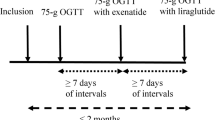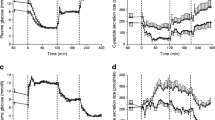Summary
The attempt has been made to identity the lowest dose of glipizide, a second generation sulphonylurea, capable of improving glucose tolerance in overweight and obese subjects with various degrees of glucose tolerance. Thirty one obese subjects, 12 with non insulin dependent diabetes mellitus (NIDDM), 9 with impaired glucose tolerance (IGT) and 10 with normal glucose tolerance (NGT) each underwent four OGTTS (75 g), at 1 week intervals, after administration in random order of placebo or glipizide 0.5, 1.0 or 2.5 mg 30 min before glucose.
Glucose tolerance in all groups was progressively improved by the increasing doses of glipizide and was normalized by 1.0 mg glipizide in impaired glucose tolerance (IGT) and by 2.5 mg glipizide in NIDDM. Insulin release was not significantly affected by glipizide in the three groups of subjects. The data indicate that it is possible, at least in acute experiments, to improve glucose tolerance in overweight and obese subjects with IGT, with NGT and with NIDDM, with doses of glipizide that do not affect insulin release.
Similar content being viewed by others
References
World Health Organization (1980) Expert Committee on Diabetes Mellitus, Second Report. WHO Technical Report Series 646: 10–12
O'Sullivan JB, Mahan CM (1968) Prospective study of 352 young patients with chemical diabetes. N Engl J Med 278: 1038–1041
Diabetes Survey Working Party (1970) Five-year follow up report on the Birmingham Diabetes Survey of 1962. Br Med J 3: 301–305
Diabetes Survey Working Party (1976) Ten-year follow up report on Birmingham Diabetes Survey of 1961. Br Med J 2: 35–37
Sasaki A, Suzuki T, Horiuchi N (1982) Development of diabetes in Japanese subjects with impaired glucose tolerance: a seven years follow up study. Diabetologia 22: 154–157
Diabetes Survey Working Party (1962) A Diabetes Survey. Br Med J 1: 1497–1503
Agner E, Thorsteinsson B, Eriksen M (1982) Impaired glucose tolerance and diabetes mellitus in elderly subjects. Diabetes Care 5: 600–604
Davidson MB (1979) The effect of aging on carbohydrate metabolism. A review of the english literature and a practical approach to the diagnosis of diabetes mellitus in the elderly. Metabolism 28: 688–705
Keen H, Jarret RJ, McCartney P (1982) The ten year follow-up of the Bedford Survey (1962–1972): glucose tolerance and diabetes. Diabetologia 22: 73–78
Jarret RJ, Keen H, Fuller JH, McCartney M (1979) Worsening to diabetes in men with impaired glucose tolerance (“borderline diabetes”). Diabetologia 16: 25–30
King H, Zimmet P, Raper LR, Balkau B (1984) The natural history of impaired glucose tolerance in the micronesian population of Nauru: a six-year follow up study. Diabetologia 26: 39–43
Kadowaki T, Miyake Y, Hagura R et al. (1984) Risk factors for worsening to diabetes in subjects with impaired glucose tolerance. Diabetologia 26: 44–49
National Diabetes Data Group (1979) Classification and diagnosis of diabetes mellitus and other categories of glucose intolerance. Diabetes 28: 1039–1057
Fuller JH, Shipley MJ, Rose G, Jarret RJ, Keen H (1980) Coronary-heart disease and impaired glucose tolerance; the Whitehall Study. Lancet I: 1373–1376
Pyorala K, Savolainen E, Lehtovirta E, Punsar S, Siltanen P (1979) Glucose tolerance and coronary-heart-disease: Helsinki policemen study. J Chron Dis 32: 729–745
Zavaroni I, Dall'Aglio E, Bonora E, Alpi O, Passeri M (1987) Evidence that multiple risk factors for coronary artery disease exist in persons with abnormal glucose tolerance. Am J Med 83: 609–612
Stowers JM (1973) Treatment of chemical diabetes with chlorpropamide and the associated mortality. Adv Metabol Disord 2 [Suppl 2]: 549–555
Sartor G, Schersten B, Carlstrom S, Melander A, Norden A, Persson G (1980) Ten-year follow-up of subjects with impaired glucose tolerance. Diabetes 29: 41–49
Blohme' G, Waldenstrom J (1979) Glibenclamide and glipizide in maturity onset diabetes. Acta Med Scand 206: 263–267
Klose Frederiksen P, Flemming Mogensen E (1982) A clinical comparison between glipizide (glibenese®) and glibenclamide (daonil®) in the treatment of maturity onset diabetes: a controlled double-blind cross-over trial. Curr Ther Res 32: 1–6
Fineberg SE, Schneider SH (1980) Glipizide versus tolbutamide, an open trial. Diabetologia 18: 49–54
Keys A, Fidanza F, Karvonen MJ, Kimura N, Taylor HL (1972) Indices of relative weight and obesity. J Chron Dis 25: 329–343
Yalow RS, Berson SA (1960) Immunoassay of endogenous plasma insulin in man. J Clin Invest 39: 1157–1162
Heding LG (1975) Radioimmunological determination of human C peptide in serum. Diabetologia 11: 541–548
Kaneto T, Oka H, Menemura M (1974) Radioimmunoassay of human proinsulin C-peptide using synthetic human connecting peptide. Endocrinol Jpn 21: 141–150
Polonsky KS, Rubenstein AH (1984) C peptide as a measure of the secretion and hepatic extraction of insulin: pitfalls and limitations. Diabetes 33: 486–494
Kollind U, Adamson P, Lins PE, Ohlsen P (1984) Extrapancreatic effects of a sulphonylurea. Acta Med Scand 215: 443–445
Groop L, Luzi L, Melander A et al. (1987) Different effects of glyburide and glipizide on insulin secretion and hepatic glucose production in normal and NIDDM subjects. Diabetes 36: 1320–1328
Pontiroli AE, Alberetto M, Bertoletti A, Baio G, Pozza G (1984) Sulfonylureas enhance in vivo the effectiveness of insulin in type I (insulin dependent) diabetes mellitus. Horm Metabol Res 16 [Suppl]: 167–170
Scheen AJ, Lefebvre PJ, Luyckx AS (1984) Glipizide increases plasma insulin but not C peptide level after a standardized breakfast in type 2 diabetic patients. Eur J Clin Pharmacol 26: 471–474
Author information
Authors and Affiliations
Rights and permissions
About this article
Cite this article
Pontiroli, A.E., Perfetti, M.G. & Pozza, G. Acute effect of glipizide on glucose tolerance in obesity and diabetes mellitus (NIDDM). Eur J Clin Pharmacol 40, 23–26 (1991). https://doi.org/10.1007/BF00315134
Received:
Accepted:
Issue Date:
DOI: https://doi.org/10.1007/BF00315134




